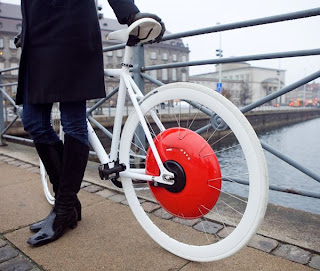 “Transform your ordinary bicycle into a hybrid e-bike that also provides feedback on pollution, traffic congestion and road conditions in real time!”
“Transform your ordinary bicycle into a hybrid e-bike that also provides feedback on pollution, traffic congestion and road conditions in real time!”
That is the opening statement on the website for the Copenhagen Wheel, a project by MIT’s SENSEable City Laboratory. With a claim like that, it is no wonder the project has been getting so much attention on the web since its debut at the COP15 climate Summit in Copenhagen a couple of days ago. Like the Sanyo Eneloop bike that I mentioned last year, this design stores kinetic energy from braking for future use by way of technology similar to the Kinetic Energy Recovery System (KERS), which has changed Formula One racing dramatically in recent years. Unlike the Sanyo bike though, this design stores that energy in a battery that is contained in the wheel, not on the frame of the bicycle. For that reason the Copenhagen Wheel is retrofitable on any type of bike (including the Cinelli Mystic pictured here courtesy of the SENSEable City Lab’s website).
 In addition to a battery and motor, the Copenhagen Wheel has a variety of other functions that are hidden within the oversized red hub. By using a series of sensors and a Bluetooth connection to the user’s iPhone, the wheel can monitor the bicycle’s speed, direction and distance traveled, as well as collect data on air pollution and even the proximity of the rider’s friends.
In addition to a battery and motor, the Copenhagen Wheel has a variety of other functions that are hidden within the oversized red hub. By using a series of sensors and a Bluetooth connection to the user’s iPhone, the wheel can monitor the bicycle’s speed, direction and distance traveled, as well as collect data on air pollution and even the proximity of the rider’s friends.
“One of the applications that we have discussed with the City of Copenhagen is that of an incentive scheme whereby citizens collect Green Miles – something similar to frequent flyer miles, but good for the environment,” says Christine Outram, who led the team of researchers at MIT.
You can read more about the technology, and the team’s ideas behind the design, at the MIT Media Relations site.
The idea of storing braking or downhill coasting energy, and using that energy for a burst of speed later is nothing new. Whitt and Wilson’s 1982 book, Bicycling Science (coincidentally…or not… published by The MIT Press), discusses energy storage systems going back many years. Thirty plus years ago, the most successful designs used flywheels to store energy (as opposed to those systems which relied on elastic bands or springs). Flywheels are heavy though, so the practical application for bicycles was pretty limited. Even with modern technology, some would argue that practical applications of energy storage systems are still debatable. In a New York Times article about the Copenhagen Wheel, Dr. William Mitchell, who runs another lab at M.I.T. called SmartCities, is quoted as saying:
“Regenerative braking hardware adds mass, complexity and cost, and the energy efficiency gains from it turn out to be surprisingly limited.”
 Steve Hed and Jens Martin Skibsted are also quoted in that NY Times article, so be sure to read it for a different perspective than you get from the MIT press releases. Another place to read about the Copenhagen Wheel is TreeHugger. They mentioned it in a post along with 4 other bike solutions spotted at COP-15.
Steve Hed and Jens Martin Skibsted are also quoted in that NY Times article, so be sure to read it for a different perspective than you get from the MIT press releases. Another place to read about the Copenhagen Wheel is TreeHugger. They mentioned it in a post along with 4 other bike solutions spotted at COP-15.
Not related to the wheel, but while I am throwing out Copenhagen related links, I’ll mention this StreetFilms video which features Mikael Colville-Anderson from Copenhaganize talking about bicycle infrastructure projects in that city. Great stuff! Watching that video akes me want to visit Copenhagen all the more.

Leave a Reply